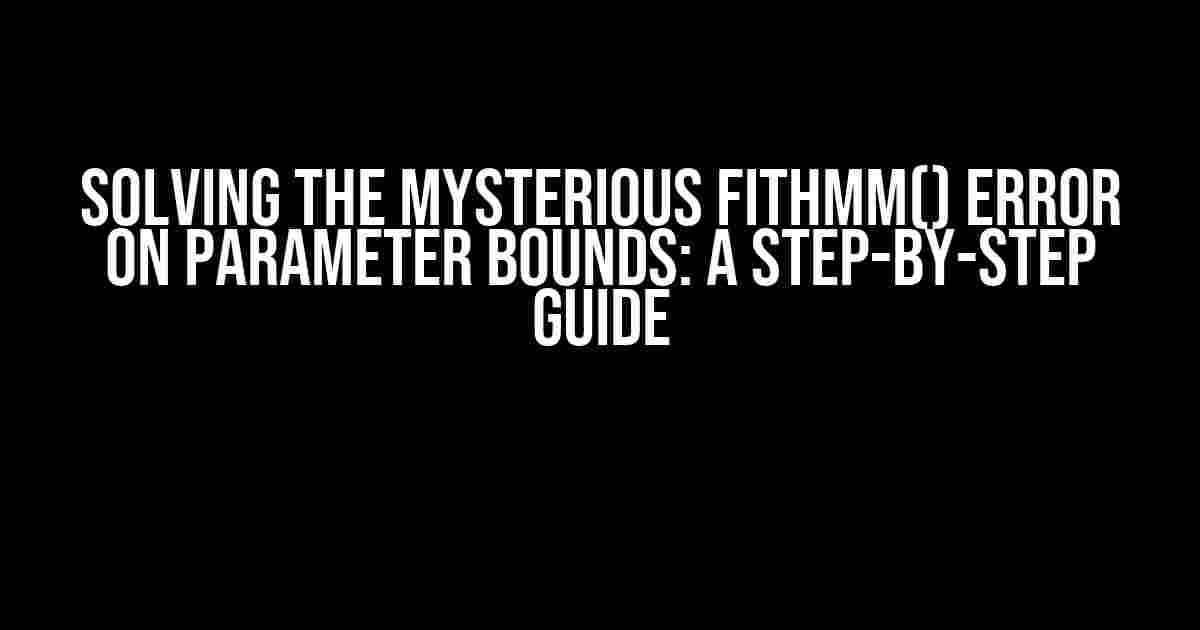If you’re reading this, chances are you’re struggling with the frustrating fitHMM() error on parameter bounds. Don’t worry, you’re not alone! This error can be perplexing, but fear not, dear reader, for we’re about to embark on a journey to conquer this obstacle together.
What is fitHMM() and Why Does it Matter?
Before we dive into the error, let’s quickly cover what fitHMM() is and why it’s essential. fitHMM() is a function in the HMM package in R, which stands for Hidden Markov Models. HMMs are a type of statistical model used to analyze and understand complex systems, such as speech recognition, gene expression, and more.
fitHMM() is used to estimate the parameters of an HMM from a given dataset. It’s a critical step in building and training an HMM, as it allows us to infer the underlying patterns and structures in the data.
The fitHMM() Error on Parameter Bounds: What’s Happening?
Now, let’s get to the crux of the matter – the error itself. The fitHMM() error on parameter bounds typically occurs when the function is unable to find a suitable set of parameters that satisfy the model’s constraints. This can happen due to various reasons, such as:
- Invalid or inconsistent data
- Insufficient data for model estimation
- Model misspecification (e.g., incorrect number of states)
- Numerical issues or instability
When this error occurs, you might see an error message similar to this:
Error in fitHMM(data = my_data, nStates = 2, nComponents = 1) : unable to find a set of parameters that satisfies the bounds
Troubleshooting the fitHMM() Error: A Systematic Approach
Don’t panic! Let’s break down the troubleshooting process into manageable chunks. Follow these steps to identify and fix the issue:
-
Check Your Data
Verify that your data is:
- Formatted correctly (e.g., numeric or categorical)
- Free of missing or duplicate values
- Suitable for the HMM (e.g., stationary, ergodic)
# Check for missing values
summary(my_data)# Check for duplicate values
duplicated(my_data)
-
Validate Your Model Specification
Double-check that your model specification is correct:
- Number of states (nStates) and components (nComponents) are valid
- Transition matrix (A) and emission matrix (B) are correctly defined
# Check model specification
str(my_hmm)
-
Explore Numerical Issues
Investigate potential numerical issues:
- Check for singular matrices or non-positive definite matrices
- Verify that the model’s parameters are within feasible bounds
# Check for singular matrices
det(my_hmm$A)# Check parameter bounds
my_hmm$par_bounds
-
Try Alternative Optimization Methods
If the above steps don’t resolve the issue, try alternative optimization methods:
- Change the optimization algorithm (e.g., from default to Nelder-Mead)
- Adjust the optimization control parameters (e.g., max iterations)
# Change optimization algorithm
fitHMM(data = my_data, nStates = 2, nComponents = 1,
optim_algorithm = 'Nelder-Mead')# Adjust optimization control parameters
fitHMM(data = my_data, nStates = 2, nComponents = 1,
control = list(maxit = 1000))
Additional Tips and Tricks
To avoid the fitHMM() error on parameter bounds, keep the following best practices in mind:
| Tips | Explanation |
|---|---|
| Scale your data | Scaling your data can improve numerical stability and reduce the risk of optimization issues. |
| Initialize parameters carefully | Choose reasonable initial values for the model parameters to facilitate optimization. |
| Monitor convergence | Keep an eye on the optimization process and stop it if convergence is not reached within a reasonable number of iterations. |
Conclusion
The fitHMM() error on parameter bounds can be frustrating, but by following this step-by-step guide, you’ll be well-equipped to identify and resolve the issue. Remember to stay patient, systematic, and creative in your troubleshooting process. With persistence and practice, you’ll become a master of HMMs and conquer the fitHMM() error once and for all!
Happy modeling!
Frequently Asked Question
If you’re stuck with the fitHMM() error on parameter bounds, don’t worry, we’ve got you covered! Here are some common questions and answers to help you troubleshoot the issue.
What does the “fitHMM() error on parameter bounds” mean?
This error typically occurs when the parameters you’ve specified for your Hidden Markov Model (HMM) are outside the valid range. Check your model’s documentation to ensure that the parameters you’re passing to fitHMM() are within the allowed bounds.
How do I determine the valid range for my HMM parameters?
Consult the documentation for the specific HMM implementation you’re using. Typically, the valid range for each parameter is specified in the documentation or can be found through trial and error. You can also try reviewing the source code or searching online forums for guidance.
What are some common mistakes that lead to parameter bounds errors?
Common mistakes include specifying negative values for probabilities, using values outside the range [0, 1] for emission or transition probabilities, or providing invalid initial state probabilities. Double-check your code to ensure that you’re passing valid parameters to fitHMM().
Can I adjust the bounds for my HMM parameters?
In some cases, you may be able to adjust the bounds for your HMM parameters. However, this is highly dependent on the specific implementation and the requirements of your model. Be cautious when adjusting bounds, as this can affect the accuracy and validity of your model’s results.
What if I’m still stuck with the “fitHMM() error on parameter bounds” after trying the above solutions?
If you’ve tried the above solutions and are still stuck, consider seeking help from online forums, documentation, or the implementation’s support resources. You can also try providing a minimal, reproducible example to help others assist you in debugging the issue.



